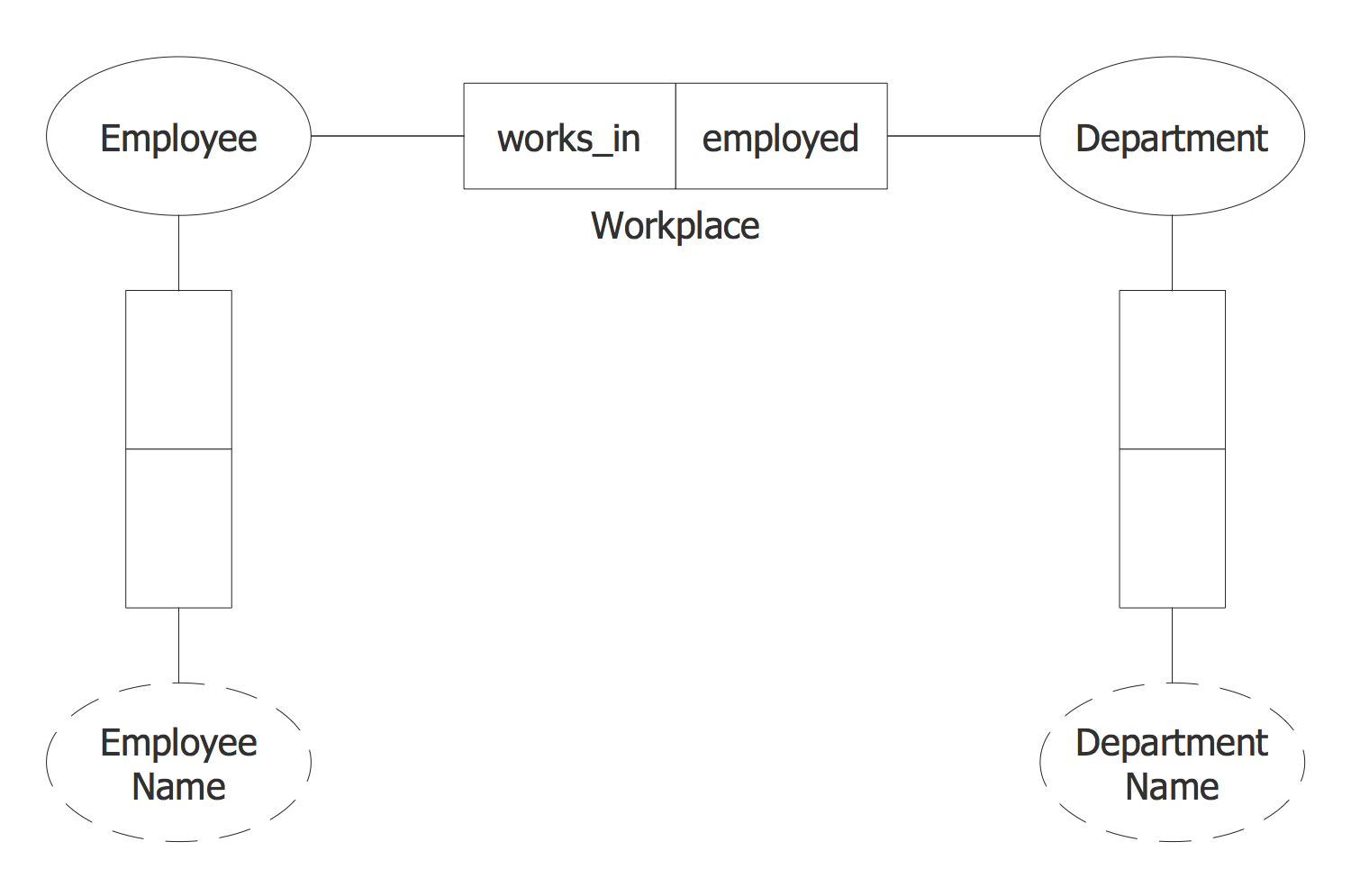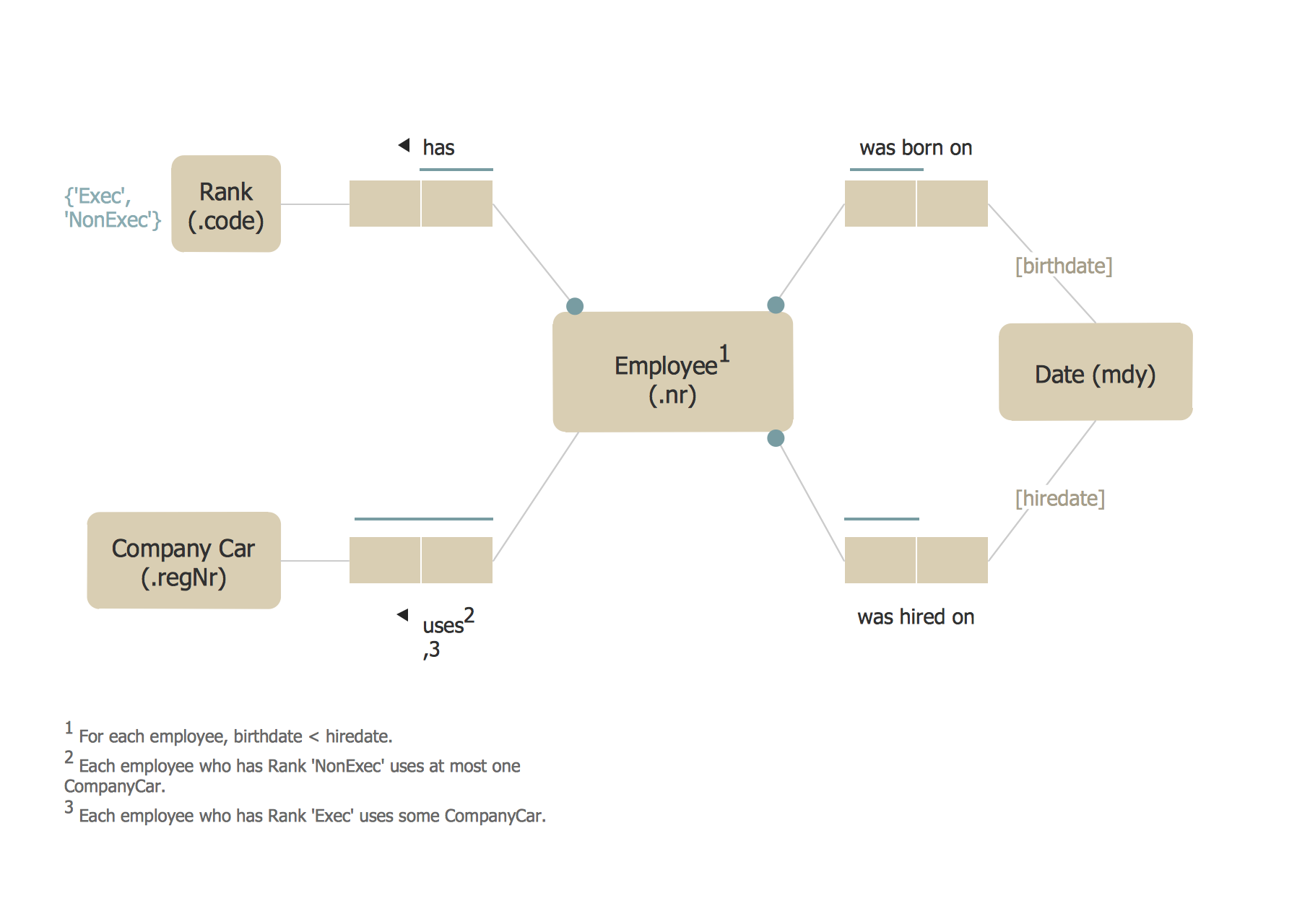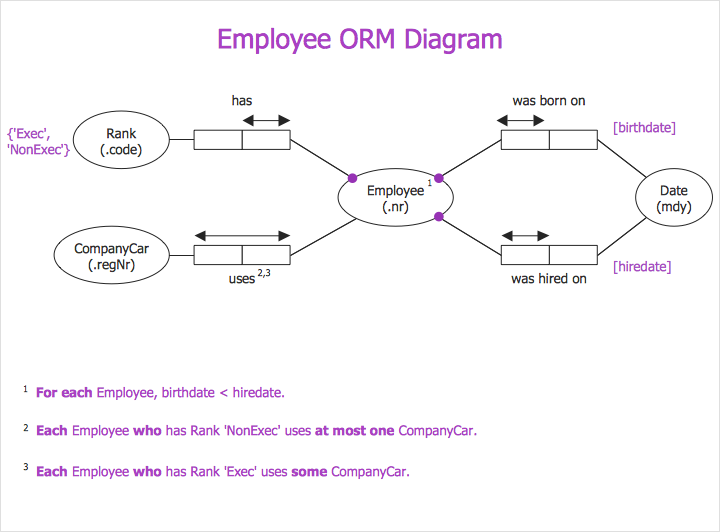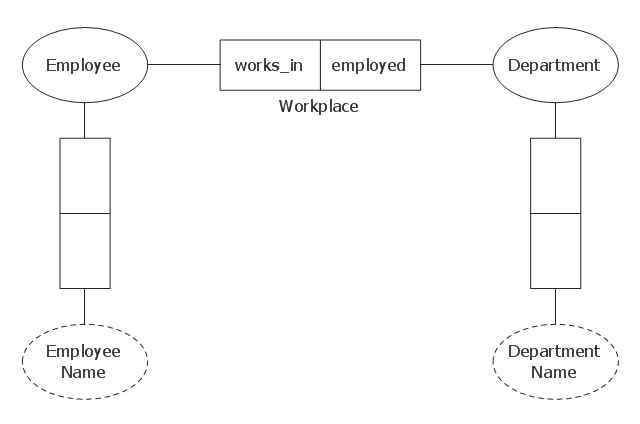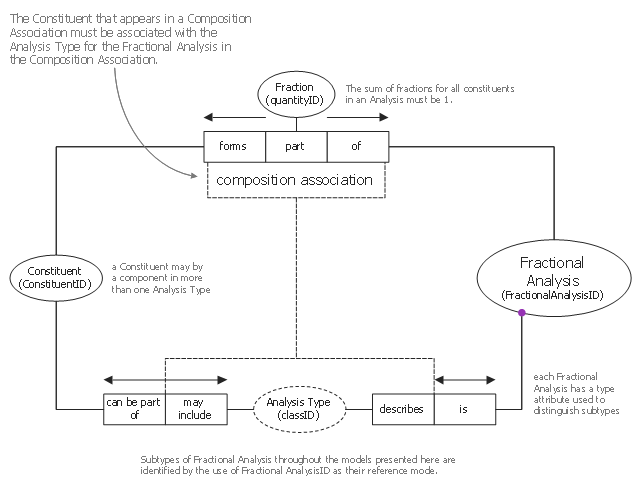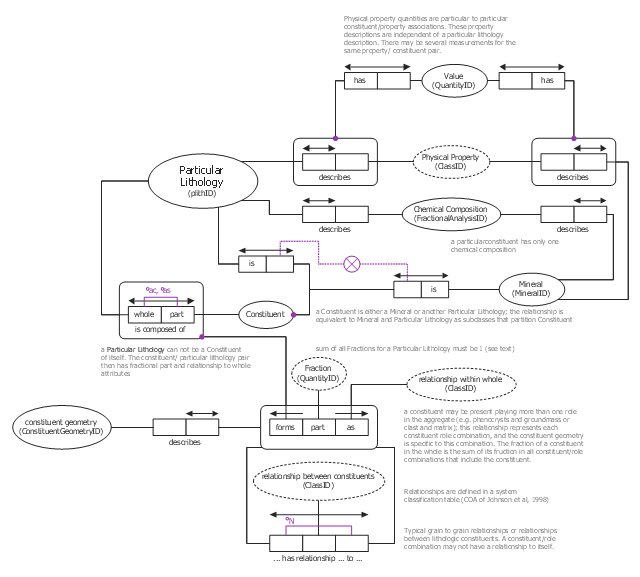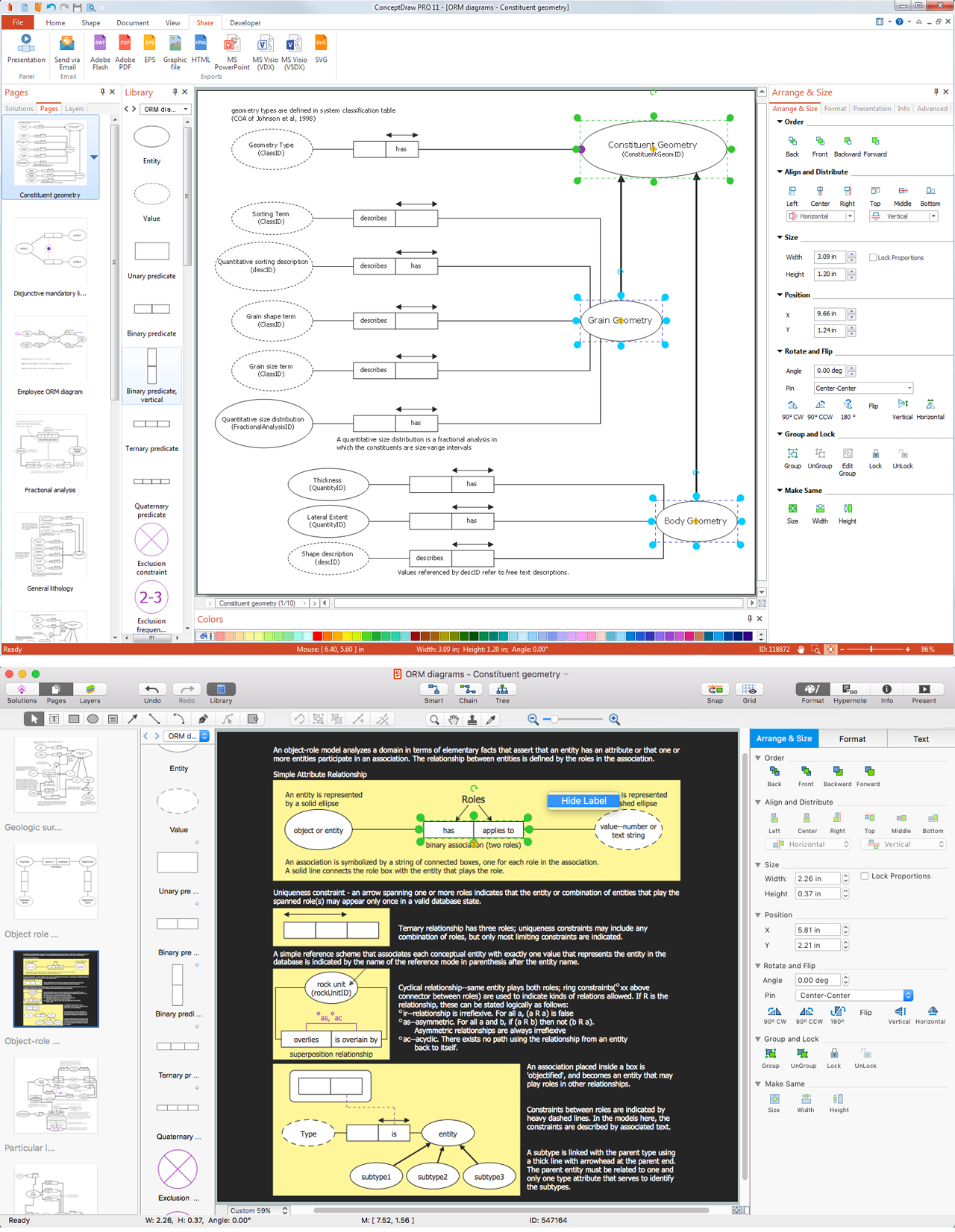 Object-Role Modeling (ORM) Diagrams
Object-Role Modeling (ORM) Diagrams
Object-role Modeling (ORM) Diagram solution with powerful vector diagramming and data modeling tools, large quantity of specially developed samples and examples, and rich variety of vector objects corresponding to common ORM notation, ideally suits for developing the comprehensive, clear and visual Object-role Modeling (ORM) diagrams and schematics, understandable for all interested people from the different fields and business directions, for designing the ORM models, and demonstrating advantages from the use of ORM and its notation. It is intended for software developers and computer engineers, specialists in a field of Object-oriented programming (OOP), database architects, web-application constructors and developers, etc.
ORM
In case some ORM drawing has to be created, such as an ORM diagram, it can become possible once the ConceptDraw DIAGRAM diagramming and drawing software is downloaded from this site being used with another product of CSO — the ConceptDraw STORE. Having the last-mentioned application, you can choose to install the Object-Role Modeling (ORM) solution in order to make any needed ORM diagram by using the pre-made templates of such drawings as well as the vector stencil libraries from the mentioned solution.ORM Diagram
The vector stencils library ORM Diagrams from the solution Software Development contains specific ORM symbols for ConceptDraw DIAGRAM diagramming and vector drawing software. The Software Development solution is contained in the ConceptDraw Solution Park.HelpDesk
How to Create an Object-Role Modeling (ORM) Diagram
Object Role Modeling (ORM) Diagrams solution extends the ConceptDraw DIAGRAM software functionality with powerful vector diagramming and data modeling tools, large quantity of specially developed samples and examples, and rich variety of vector objects corresponding to common ORM notation, which are convenient for using when developing the comprehensive, clear and visual Object Role Modeling (ORM) diagrams and schematics.This object-role modeling (ORM) diagram sample was designed on the base of the Wikimedia Commons file: Orm modell beispiel.gif. [commons.wikimedia.org/ wiki/ File:Orm_ modell_ beispiel.gif]
"Object-role Modeling (ORM) is a fact-oriented modeling approach for expressing, transforming and querying information at a conceptual level. Unlike Entity-Relationship modeling and Unified Modeling Language class diagramming, fact-oriented modeling is attribute-free, treating all elementary facts as relationships expressed in natural language sentences. For information modeling, ORM graphical notations are typically far more expressive than other notations, and ORM’s attribute-
free nature promotes semantic stability and facilitates natural verbalization." [www.orm.net/ pdf/ ORM2_ TechReport1.pdf]
The object-role model example "Object role modeling example" was designed using ConceptDraw PRO software extended with ORM Diagrams solution from Software Development area of ConceptDraw PRO Solution Park.
"Object-role Modeling (ORM) is a fact-oriented modeling approach for expressing, transforming and querying information at a conceptual level. Unlike Entity-Relationship modeling and Unified Modeling Language class diagramming, fact-oriented modeling is attribute-free, treating all elementary facts as relationships expressed in natural language sentences. For information modeling, ORM graphical notations are typically far more expressive than other notations, and ORM’s attribute-
free nature promotes semantic stability and facilitates natural verbalization." [www.orm.net/ pdf/ ORM2_ TechReport1.pdf]
The object-role model example "Object role modeling example" was designed using ConceptDraw PRO software extended with ORM Diagrams solution from Software Development area of ConceptDraw PRO Solution Park.
This ORM diagram sample presents object-role model overview.
It was designed on the base of the Wikimedia Commons file: Object-Role Model Overview.jpg. [commons.wikimedia.org/ wiki/ File:Object-Role_ Model_ Overview.jpg]
"Object-role modeling (ORM) is used to model the semantics of a universe of discourse. ORM is often used for data modeling and software engineering.
An object-role model uses graphical symbols that are based on first order predicate logic and set theory to enable the modeler to create an unambiguous definition of an arbitrary universe of discourse. Attribute free, the predicates of an ORM Model lend themselves to the analysis and design of graph database models in as much as ORM was originally conceived to benefit relational database design. ...
More recently ORM has been used to model business rules, XML-Schemas, data warehouses, requirements engineering and web forms." [Object-role modeling. Wikipedia]
The ORM diagram example "Object-role model overview" was designed using ConceptDraw PRO software extended with ORM Diagrams solution from
Software Development area of ConceptDraw PRO Solution Park.
It was designed on the base of the Wikimedia Commons file: Object-Role Model Overview.jpg. [commons.wikimedia.org/ wiki/ File:Object-Role_ Model_ Overview.jpg]
"Object-role modeling (ORM) is used to model the semantics of a universe of discourse. ORM is often used for data modeling and software engineering.
An object-role model uses graphical symbols that are based on first order predicate logic and set theory to enable the modeler to create an unambiguous definition of an arbitrary universe of discourse. Attribute free, the predicates of an ORM Model lend themselves to the analysis and design of graph database models in as much as ORM was originally conceived to benefit relational database design. ...
More recently ORM has been used to model business rules, XML-Schemas, data warehouses, requirements engineering and web forms." [Object-role modeling. Wikipedia]
The ORM diagram example "Object-role model overview" was designed using ConceptDraw PRO software extended with ORM Diagrams solution from
Software Development area of ConceptDraw PRO Solution Park.
This object-role modeling (ORM) diagram sample shows schema for geologic fractional analysis.
It was designed on the base of the Wikimedia Commons file: Schema for Fractional Analysis.gif. [commons.wikimedia.org/ wiki/ File:Schema_ for_ Fractional_ Analysis.gif]
"The Fractional Analysis (Figure 3) concept is used to model any situation in which an entity is composed of other entities in certain proportions. Common examples are chemical analyses, grain size-distributions, and modal mineralogy. Constituent types used in Fractional Analyses are specified in a system classification table. Constituents that are used as fractional parts of a described entity must be allowed as components of a Fractional Analysis of the Described Entity." [pubs.usgs.gov/ of/ 1999/ of99-386/ richard.html]
The object-role model example "Fractional analysis ORM diagram" was designed using ConceptDraw PRO software extended with ORM Diagrams solution from Software Development area of ConceptDraw PRO Solution Park.
It was designed on the base of the Wikimedia Commons file: Schema for Fractional Analysis.gif. [commons.wikimedia.org/ wiki/ File:Schema_ for_ Fractional_ Analysis.gif]
"The Fractional Analysis (Figure 3) concept is used to model any situation in which an entity is composed of other entities in certain proportions. Common examples are chemical analyses, grain size-distributions, and modal mineralogy. Constituent types used in Fractional Analyses are specified in a system classification table. Constituents that are used as fractional parts of a described entity must be allowed as components of a Fractional Analysis of the Described Entity." [pubs.usgs.gov/ of/ 1999/ of99-386/ richard.html]
The object-role model example "Fractional analysis ORM diagram" was designed using ConceptDraw PRO software extended with ORM Diagrams solution from Software Development area of ConceptDraw PRO Solution Park.
This object-role modeling (ORM) diagram sample shows schema for particular lithology.
It was designed on the base of the Wikimedia Commons file: Schema for Particular Lithology.gif. [commons.wikimedia.org/ wiki/ File:Schema_ for_ Particular_ Lithology.gif]
"The Particular Lithology schema (Figure 5) models the description of a particular rock. The information system should include a set of idealized "typical' Particular Lithology entities associated with each General Lithology to provide default values for characteristics not specified in the General Lithology definition. The Particular Lithology entity will also be used for the description of rock hand samples. A Particular Lithology is modeled as an aggregate of Constituents. The Constituents may be Mineral or other Particular Lithology entities, allowing for recursive description. Each Constituent may be involved in one or more Relationship_ within_ Whole associations (see Table 1 for examples) with the Particular Lithology." [pubs.usgs.gov/ of/ 1999/ of99-386/ richard.html]
The object-role model example "Particular lithology ORM diagram" was designed using ConceptDraw PRO software extended with ORM Diagrams solution from Software Development area of ConceptDraw PRO Solution Park.
It was designed on the base of the Wikimedia Commons file: Schema for Particular Lithology.gif. [commons.wikimedia.org/ wiki/ File:Schema_ for_ Particular_ Lithology.gif]
"The Particular Lithology schema (Figure 5) models the description of a particular rock. The information system should include a set of idealized "typical' Particular Lithology entities associated with each General Lithology to provide default values for characteristics not specified in the General Lithology definition. The Particular Lithology entity will also be used for the description of rock hand samples. A Particular Lithology is modeled as an aggregate of Constituents. The Constituents may be Mineral or other Particular Lithology entities, allowing for recursive description. Each Constituent may be involved in one or more Relationship_ within_ Whole associations (see Table 1 for examples) with the Particular Lithology." [pubs.usgs.gov/ of/ 1999/ of99-386/ richard.html]
The object-role model example "Particular lithology ORM diagram" was designed using ConceptDraw PRO software extended with ORM Diagrams solution from Software Development area of ConceptDraw PRO Solution Park.
Data Modeling Tools
There are many tools that are used within data modeling processes but to make the correct model it is always better to draw it graphically so it becomes more obvious whether it is good enough to use or not. Having the ConceptDraw DIAGRAM diagramming and drawing software may lead to creating the great looking ORM drawings, such as ORM diagrams, especially if you have the Object-Role Modeling (ORM) solution downloaded from the ConceptDraw STORE application — another product of CS Odessa that can be used by all the ConceptDraw DIAGRAM users.- New Object-Role Modeling Diagrams Solution for ConceptDraw PRO
- ConceptDraw PRO Database Modeling Software | Software ...
- Object role modeling
- Object role modeling example
- ConceptDraw PRO Database Modeling Software | | Free Orm ...
- Unified Modeling Language Tutorial
- Material Requisition Flowchart. Flowchart Examples | Object-Role ...
- Object-Role Modeling ( ORM ) Diagrams | Mathematics ...
- Conceptdraw.com: Mind Map Software, Drawing Tools | Project ...
- ORM Diagram | Software Diagrams | SSADM Diagram | Freeware To ...
